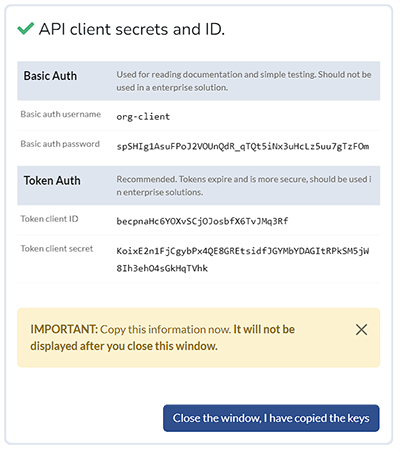¶ What are the different API's that Enin offer?
Enin provides two primary APIs designed to deliver comprehensive insights into companies.
- Analysis API: Our most popular API - The analysis API offer a wide variety of endpoints that give you information about an entity.
- Datasets API: For bulk download of Enin data and analyses.
¶ Get API credentials
¶ Connect with Sales
To start, get in touch with our sales team:
- Contact form
- Email: sales@enin.ai
The sales team will give you access to the Enin application.
¶ Setting Up API access
After logging into the Enin Application, you setup API access via the settings page. Click "Create api client" and you’ll receive Basic Authentication credentials. Keep these secure.

¶ Test your connection
Test your connection by doing a GET request to the Analysis API auth-status with Basic HTTP Authentication. Successful authentication returns a "You are authenticated" message.
Use your Basic auth username and password
- Your Basic auth username should look something like this:
organizaition-client - And your Basic auth password should look something like this:
Ab3124586Jpwkqnqwpiqjwrqwlqwwmsadoj6omqawz4pothpokerhj25qpwkra
curl -u "username:password" https://api.enin.ai/analysis/v1/auth-status
import requests
from requests.auth import HTTPBasicAuth
# Define the URL and credentials
url = 'https://api.enin.ai/analysis/v1/auth-status'
username = 'mym_basic_auth_username'
password = 'my_basic_auth_password'
# Make the request with Basic Authentication
response = requests.get(url, auth=HTTPBasicAuth(username, password))
# Print the response text
print(response.text)
response.text should say "You are authenticated".
import java.io.BufferedReader;
import java.io.InputStreamReader;
import java.net.HttpURLConnection;
import java.net.URL;
import java.util.Base64;
public class BasicAuthRequest {
public static void main(String[] args) {
try {
String url = "https://api.enin.ai/analysis/v1/auth-status";
String username = "my_basic_auth_username";
String password = "my_basic_auth_password";
URL urlObj = new URL(url);
HttpURLConnection connection = (HttpURLConnection) urlObj.openConnection();
String auth = username + ":" + password;
String encodedAuth = Base64.getEncoder().encodeToString(auth.getBytes());
String authHeaderValue = "Basic " + encodedAuth;
connection.setRequestProperty("Authorization", authHeaderValue);
BufferedReader in = new BufferedReader(new InputStreamReader(connection.getInputStream()));
String inputLine;
StringBuffer content = new StringBuffer();
while ((inputLine = in.readLine()) != null) {
content.append(inputLine);
}
in.close();
System.out.println(content.toString());
} catch (Exception e) {
e.printStackTrace();
}
}
}
Your terminal should print out "You are authenticated".
using System;
using System.Net.Http;
using System.Net.Http.Headers;
using System.Threading.Tasks;
class Program
{
static async Task Main(string[] args)
{
var client = new HttpClient();
var url = "https://api.enin.ai/analysis/v1/auth-status";
var username = "my_basic_auth_username";
var password = "my_basic_auth_password";
var byteArray = System.Text.Encoding.ASCII.GetBytes($"{username}:{password}");
client.DefaultRequestHeaders.Authorization = new AuthenticationHeaderValue("Basic", Convert.ToBase64String(byteArray));
var response = await client.GetAsync(url);
var content = await response.Content.ReadAsStringAsync();
Console.WriteLine(content);
}
}
Your console should print "You are authenticated".
Requires axios, run npm install axios
const axios = require('axios');
// API URL
const url = 'https://api.enin.ai/analysis/v1/auth-status';
const username = 'my_basic_auth_username';
const password = 'my_basic_auth_password';
// Encode credentials for Basic Auth header
const auth = Buffer.from(`${username}:${password}`).toString('base64');
axios.get(url, {
headers: {
'Authorization': `Basic ${auth}`
}
})
.then((response) => {
console.log(response.data);
})
.catch((error) => {
console.log(error);
});
Your console.log should say "You are authenticated".
This R script uses the httr library to make the GET request: install.packages("httr")
library(httr)
# API URL
url <- "https://api.enin.ai/analysis/v1/auth-status"
# Credentials
username <- "my_basic_auth_username"
password <- "my_basic_auth_password"
# Make the request with Basic Authentication
response <- GET(url, authenticate(username, password))
content(response, "text")
You should get the result: "You are authenticated".
¶ Basic Auth vs Token Auth
Enin now offers Basic HTTP Authentication, for new customers.
Some customers have access to Token Based Authentication. This is something we can offer in certain circumstances. Authentication guide
¶ Recommended Resources
To learn more about the Enin API we recommend that you continue reading about your chosen API: